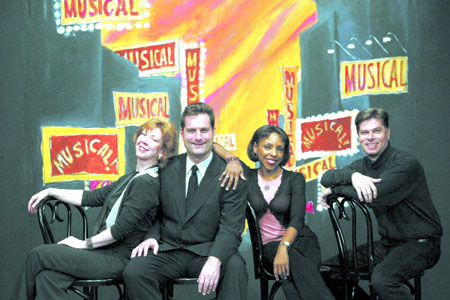Zany, zippy spoof of Broadway musicals hits some evil notes
As the lights go up (there is no curtain) at the start of “The Musical of Musicals—The Musical!” the stage is bare; the only element that might qualify as the “set” is a piano. But it’s not a grand piano—it’s one of those uprights, whose ugly unfinished wooden posterior glares at the audience.
How fitting for a parody of various Broadway musical genres that strives to strip those eager-to-please extravaganzas of their artifice to expose a not-so-glamorous underbelly. But is it enough?
“The Musical of Musicals” is a series of five deliriously twisted segments that are riffs on the same basic story, each done in the trademark style of Broadway über-meisters, from Jerry Hermann to Sondheim. This capriciously droll production thrusts these icons on a skewer one by one, rubs in plenty of salt, and roasts them gently over a hot, merciless fire. All with a sinister grin.
Much of the show is as scant as the set. The costumes, simple black outfits that might have come from the actor’s closets—yes, even the boa—are scarcely costumes at all. There’s no orchestra. The piano supplies the sole musical accompaniment, except at the finale.
The cast consists of only four members, who double as the chorus. The Playbill snidely re-minds us that understudies never appear “because there aren’t any.” Luckily, these performers unfurl enough talent to fill a Broadway stage. Well, a small Off Broadway stage, anyway.
Though the production values may not live up to the show’s glitzy title, the exuberant singing and dancing truly delivers. And the brashly clever songs, by Eric Rockwell and Joanne Bogart, who are also in the cast, really are the stars of the show. The superb melodies, wry lyrics, and pointed phrasing could, if you’re not paying attention, easily be mistaken for the originals they mock.
The plot parodied in each segment is aptly one of the most hackneyed in show biz. A woebegone belle is unable to pay her rent, and the ruthless landlord threatens eviction. Can a handsome young hero come to her rescue?
Characters remain constant, though their names morph slightly to suit each style. Lovette George performs the distressed June character (aka Jeune, Junie Faye, Junita, Juny) with a keen balance of sweetness and pluck. The hapless hero roles (Billy, William, etc.) are well played by the energetic Craig Fols. As the wise, been-around-the-block older woman (Mother Abby, Auntie Abby, etc.), Bogart is hilarious. And it’s a hoot to watch Rockwell portray the villainous roles, all the while pounding away behind that piano.
If this all sounds exceedingly silly, well, that’s the point. But it’s also relentlessly smart. It’s a game to see how many references to Broadway shows you can identify—even more fun than finding “Nina” embedded in a Hirschfeld illustration. Director Pamela Hunt paces the action briskly, which makes for few lulls between the laughs. Jokes are hurled so fast and furious they’re not always easy to catch.
Though anyone can find amusement in this show, it’s best to be a theater buff to fully appreciate it. In the Rogers and Hammerstein–esque piece, if you haven’t seen “Oklahoma,” “The Sound of Music,” “South Pacific,” “The King and I,” or “Cinderella,” you’ll be lost. When the goofy Curley-like character, known as “Big Willie,” wails, with a heavy hint of sarcasm, “Oh, what beautiful corn,” you know he ain’t talkin’ ‘bout no vegetables.
Sondheim is portrayed as a pretentious, dissonant bore. His characters live in a psychologically complex apartment complex, singing zingers like, “This is all too deep—I’m falling asleep.” Often their faces, pained and dazed, are starkly lit to enhance the eeriness. Prior knowledge of “Into the Woods,” “Follies,” “Company,” and “Assassins” helps here.
In the segment styled after Jerry Herman, the “Hello Dolly”-ish character blithely belts out, “I can’t sing or dance, but I’m the star of the show.” Later, after hosting a grand party she croons, à la Auntie Mame, “Did I put out enough?” No doubt there were references to “La Cage” as well, but since I never saw the musical version, I missed them.
The Andrew Lloyd Weber portion, a mock rock opera, is the most acerbically irreverent. In this heady mix of “Phantom,” “Evita,” “Sunset Boulevard,” “Cats,” “Jesus Christ Superstar,” and more, one refrain repeats over and again, “I’ve heard that song before.” Later, the performers moan, “It might sound a teeny like something by Puccini,” and suggest the audience’s wild applause is really for the set changes and smoke machine.
The most entertaining piece, in the genre of Kander and Ebb, devilishly combines “Chicago” and “Cabaret,” with dead-on choreography and deadpan impersonations. The emcee sings, in a goofy German accent, “Better drink your wine, ‘cause life’s a Cabernet.” A joke involving a prostitute who earned $50.10 in one day, as delivered by Bogart—I won’t spoil it here—is the funniest I’ve heard this season.
“The Musical of Musicals” is a sharp, sly indictment of the mega-musical as a glitzy, shallow, manipulative, tourist-pleaser that stoops to an absurdly low common denominator. More lacerating than loving, it’s as if Carol Burnett teamed with Mike Myers to do “Forbidden Broadway”… with no budget.
The York Theatre Company, which claims to be the only group in New York dedicated to shepherding musicals from inception to full production, should be praised for its effort. Yet, somehow, this extremely spare, no-frills production left me wanting much more. Expanded sets, orchestra, costumes, and and a deeper cast, perhaps?


































